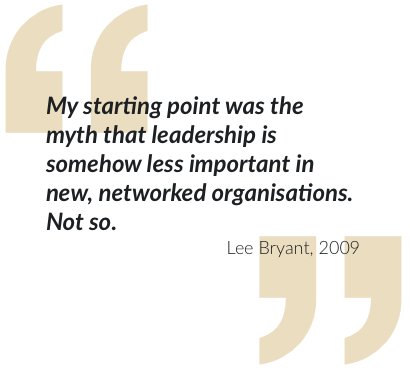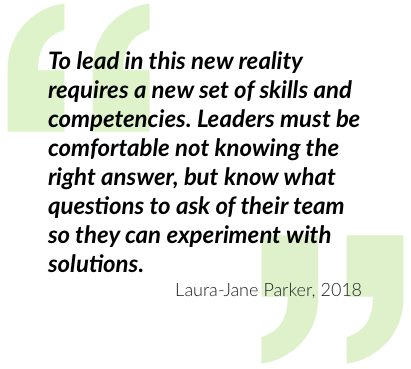Leadership
Digital Workplace Futures
As the digital workplace has evolved, our ideas of leadership have also been impacted. Although many leaders struggle with digital skills, there is an emerging cadre of digital leaders coming to the fore. Many organisations are now focusing on enabling their leaders to adopt a digital mindset alongside learning some of the basics they still need to build.
Some of the most difficult concepts for leaders in the digital age are not technology focused at all, but rather the shift from leaders as all-knowing heroes to serving their teams. When leaders truly embrace the digital workplace, it opens up a whole new world of management techniques to influence the organisation around them.
> Introduction
> Technology
> Ownership
> Community
> Design
> Collaboration
> Skills
> Change Agents
> Leadership
> Org Structure
> Measurement
> Conclusion
- SHIFT 1: Absent-by-design
- SHIFT 2: Emerging Digital Leaders
- SHIFT 3: Digital Leadership Networks
- NEXT: The Learning Leader
- SHIFT 1: Absent-by-design
In early social collaboration experiments, senior leaders were notable for their absence. It was left to managers and team leads to encourage participation, and very often they were more concerned with ensuring the organisations process engine continues to run, rather than innovating how employees were getting work done.
More recently, the crushing cost of bureaucracy on organisations was explored in the book “Time, Talent, Energy: Overcome Organizational Drag and Unleash Your Team’s Productive Power” by Michael Mankins and Eric Garton. One traditional leadership meeting was soaking up 300,000 hours per year, and another middle management meeting was costing $15m per year. This approach to management is a key factor holding organisations back. Even though these early tools were crude in comparison to those we have now, they had the potential to enable better ways to co-ordinate work. However, with leaders not encouraged to take part, the impact of them was limited.
Against the odds, a few enlightened leaders emerged engaging on external social networks such as Twitter and Linkedin. However, they were viewed with skepticism by peers who felt that either they were wasting time or seeking to enhance their own profile.
I spend a lot of my time coaching ( aka torturing) senior leaders and training (aka encouraging / boosting) emerging leaders to take control these days #PS_Salon
— Lee Bryant (@leebryant) April 5, 2019
- SHIFT 2: Emerging Digital Leaders
Digital-savvy employees began to build communities at the edges of their organisations, discussing mega-trends and drawing others into collaborative explorations. These employees became emerging digital leaders – a group who understood that leadership in the 21st century has little to do with your position in the hierarchy, but instead your ability to influence others regardless of location.
These emerging digital leaders were imaginative in their use of the tool sets available, seamlessly moving from internal to external tools, sharing their messages with a variety of audiences as part of their sense-making activities. They embraced the lessons of the internet-age such as ‘done is better than perfect’ and ‘fear of failure is actually a fear of learning’.
As other leaders dabbled in the digital space, they discovered a new set of digital skills they needed to embrace before they could keep up with the emerging digital leaders. However, these emerging digital leaders also needed to grow business leadership skills and commercial acumen, and were able to take advantage of reverse mentoring opportunities offered – a win-win for both groups.
- SHIFT 3: Digital Leadership Networks
A good digital leadership network mixes digital-savvy emerging leaders with existing leaders who perhaps have more in-depth knowledge of the market and can keep the digital passionates grounded in addressing real customer needs as well as identifying big future opportunities afforded by digital.
This group can often build a more credible digital story that can be understood across the organisation. They can also connect and promote digital standards to ensure distributed activities and projects are interoperable, but without imposing central controls. There is no one fixed model for leadership, we need diversity, inclusive-thinking and a healthy dose of curiosity to keep modern organisations on course for the future of work.
#PS_Salon we have had some recent success with this combination. Leaders especially appreciate the opportunity to learn and apply knowledge. Learning tech & collaboration tech are fundamentally no different!
— Cerys Hearsey 👩🏻💻🧜🏻♀️ (@CerysHearsey) April 5, 2019
- NEXT: The Learning Leader
Future leaders will have a single imperative – to become a learning leader. There is no possibility of standing still – learning must match the exponential rate of change we see in markets, technology & customers.
Leaders will need to focus on digital, cultural & emotional intelligence with the same seriousness with which they currently address the more traditional areas of leadership such as commercial acumen & thought leadership.
The workforce is already shifting in the direction of hybrid teams of robots and humans, creating an augmented intelligent workforce. Learning to lead such a group requires more situational leadership skills than ever before.
Finally, leaders of the future will need to challenge the legacy and status quo holding the organisation back. This is essential to ensure that the organisation isn’t just building a digital veneer on an analogue organisation.


